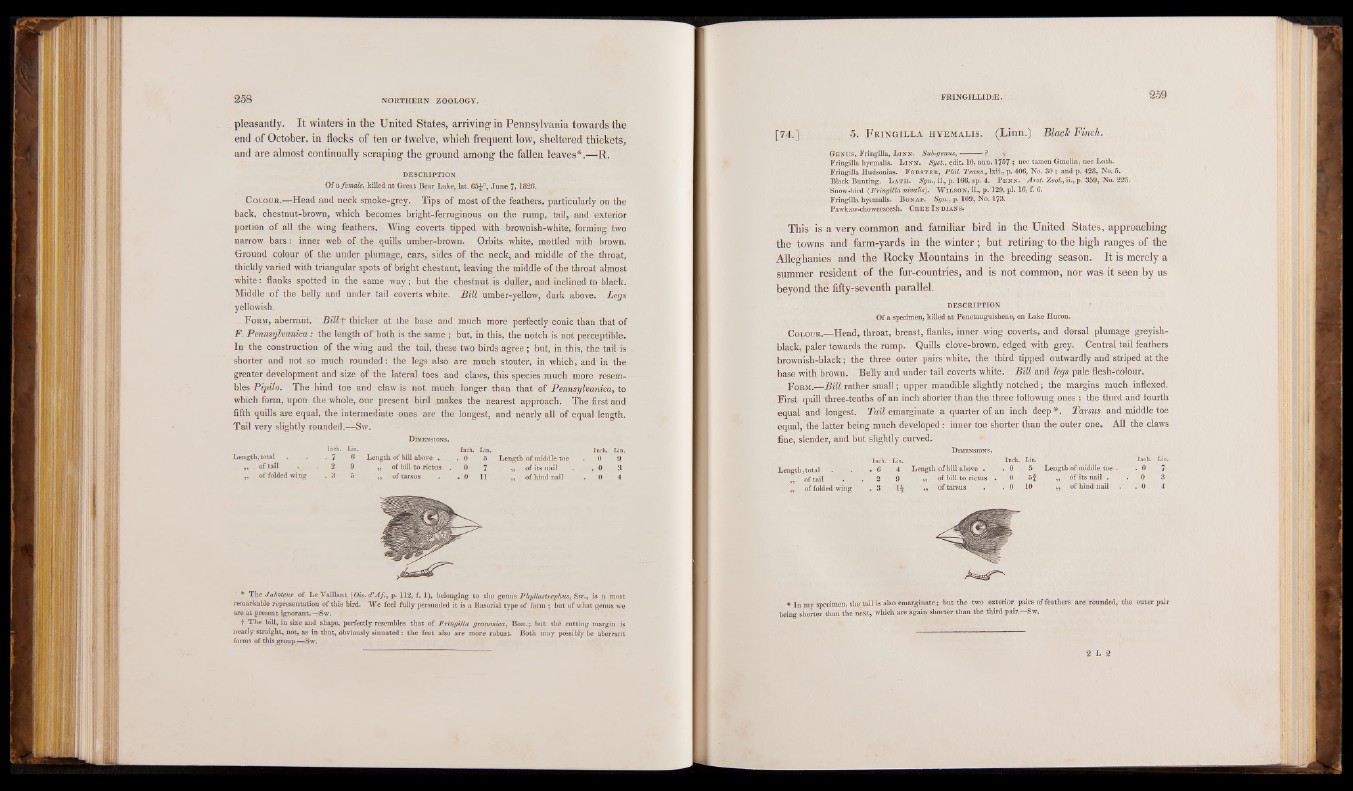
pleasantly. It winters in the United States, arriving in Pennsylvania towards the
end of October, in flocks of ten or twelve, which frequent low, sheltered thickets,
and are almost continually scraping the ground among the fallen leaves*.—R.
DESCRIPTION
Of a female, killed at Great Bear Lake, lat. 65j°, June 7, 1826.
Colour.—Head and neck smoke-grey. Tips of most of the feathers, particularly on the
back, chestnut-brown, which becomes bright-ferruginous on the rump, tail, and exterior
portion of all the wing feathers. Wing coverts tipped with brownish-white, forming two
narrow bars: inner web of the quills umber-brown. Orbits white, mottled with brown.
Ground colour of the under plumage, ears, sides of the neck, and middle of the throat,
thickly varied with triangular spots of bright chestnut, leaving the middle of the throat almost
white: flanks spotted in the same way; but the chestnut is duller, and inclined to black.
Middle of the belly and under tail coverts white. Bill umber-yellow, dark above. Legs
yellowish.
Form, aberrant. B illf thicker at the base and much more perfectly conic than that of
F. Pennsylvania: the length of"both is the same ; but, in this, the notch is not perceptible.
In the construction of the wing and the tail, these two birds agree; but, in this, the tail is
shorter and not soT much rounded: the legs also are much stouter, in which, and in the
greater development and size of the lateral toes and claws, this species much more resembles
Pipilo. The hind toe and claw is not much longer than that of Pennsylvania, to
which form, upon the whole, our present bird makes the nearest approach. The first and
fifth quills are equal, the intermediate ones are the longest, and nearly all of equal length.
Tail very slightly rounded.—Sw.
D im en s io n s.
Length, total
Inch. Lin.
. 7 6 Length of bill above .
Inch.
. 0
Lin.
,, of tail 2 9 Length of middle toe 0 9 „ of bill to rictus 7 „ of its nail . 0 3 ,, of folded wing . 3 5 „ of tarsus • o 11 ,, of hind nail . 0 4
* The Jdbotev/r of Le Vaillant (Ois. d' Af., p. 112, f. 1), belonging to the genus Pkgllastrephus, Sw., is a most
remarkable representation of this bird. We feel fully persuaded it is a Rasorial type of form ; but of what genus we
are at present ignorant.—rSw.
t The bill, in size and shape, perfectly resembles that of Fringilla grammica, Bon.; but thé cutting margin is
nearly straight, not, as in that, óbviously sinuated: the feet also are more robust. Both may possibly be aberrant
forms of this group.—Sw.
[74.] 5. F r in g il l a h y e m a l is . (Linn.) Black Finch.
Ge n u s , Fringilla, L in n . Sub-genus, --------• ? y
Fringilla hyemalis. L in n . Sgst., edit. 10, ann. 1757 ; nec tarnen Gmelin, nec Lath.
Fringilla Hudsonias. F oRs t e u , Phil. Trans., lxii., p. 406, No. 30 ; and p. 428, No. 5.
Black Bunting. L a th . Syn., ii., p. 166, sp. 4. P e n n . Aret. Zool., ii., p. 359, No. 225.
Snow-bird {Fringilla nivalis'). W il s o n , ii., p. 129, pi. 16, f. 6.
Fringilla hyemalis. B o nap. Syn., p. 109, No. 173.
Pawkäw-choweeseesh. Cb.e e I n d ia n s.
This is a very common and familiar bird in the United States, approaching
the towns and farm-yards in the winter ; but retiring to the high ranges of the
Alleghanies and the Rocky Mountains in the breeding season. It is merely a
summer resident of the fur-countries, and is not common, nor was it seen by us
beyond the fifty-seventh parallel.
DESCRIPTION
Of a specimen, killed at Penetanguishene, on Lake Huron.
Colour.—Head, throat, breast, flanks, inner wing coverts, and dorsal plumage greyish-
black, paler towards the rump. Quills clove-brown, edged with grey. Central tail feathers
brownish-black; the three outer pairs white, the third tipped outwardly and striped at the
base with brown. Belly and under tail coverts white. Bill and legs pale flesh-colour.
Form.—Bill rather small; upper mandible slightly notched ; the margins much indexed.
First quill three-tenths of an inch shorter than the three following ones : the third and fourth
equal and longest. Tail emarginate a quarter of an inch deep *. Tarsus and middle toe
equal, the latter being much developed: inner toe shorter than the outer one. All the claws
fine, slender, and but slightly curved.
D im en s io n s.
Inch. Lin.
Length, total . . . 6 4
,, of tail • . 2 9
,, of folded wing . 3 1^
Inch. Lin.
Length of bill above . . 0 5
„ of bill to rictus • 0 5f-
„ of tarsus . . 0 10
Inch. Lin.
Length of middle toe . . 0 7
’ „ ' of its nail . . 0 3
, . of hind nail . . 0 4
* In my specimen, the tail is also emarginate; but the two exterior pairs of feathers are rounded, the outer pair
being shorter than the next, which are again shorter than the third pair.—Sw.